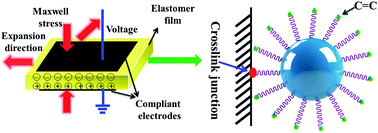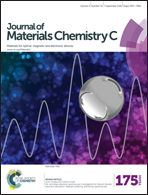Improved electromechanical properties of NBR dielectric composites by poly(dopamine) and silane surface functionalized TiO2 nanoparticles†
Abstract
In order to obtain a nitrile-butadiene rubber (NBR) dielectric elastomer composite with excellent electromechanical properties, a combination of bio-inspired poly(dopamine) (PDA) deposition and γ-methacryloxypropyl trimethoxy silane (KH570) grafting was proposed to functionalize the surface of titanium dioxide (TiO2) nanoparticles. Inspired by adhesive proteins in mussels, dopamine self-polymerization was used to deposit a thin adherent PDA film onto the surface of TiO2. KH570 that contains double bonds was then grafted through the reactions with hydroxyl and indole groups of the PDA surface. The chemical structure and composition of the TiO2 surface were characterized by XPS, FTIR, and HR-TEM. Because of the introduction of PDA grafted with the KH570 layer, the NBR composites filled with modified TiO2 displayed better filler dispersion, higher dielectric constant, lower elastic modulus, and higher electric breakdown field compared with composites filled with pristine TiO2 particles. Finally, a large actuated strain of about 16% at 60 kV mm−1 without any pre-strains was shown by the composite of NBR filled with 20 phr modified TiO2 particles, which is 53% larger than that of NBR without a filler. The process was fast, simple, efficient, nontoxic, and controllable, which can provide a new universal method for modification of dielectric fillers to improve the dielectric properties and electromechanical properties of dielectric elastomers.


 Please wait while we load your content...
Please wait while we load your content...